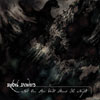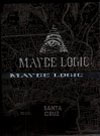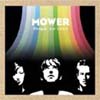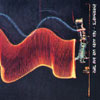 In the office where I worked this summer, the main lobby featured anenormous piece by artist Frank Stella. The piece was large, probablytwenty feet tall, and consisted of a series of colored boxes, enclosedin a thick orange boarded and symmetrically mirrored on the oppositeside. These are the kind of works, abstract shapes and colors, thatmade Stella and his minimalist style known in the art world. Everymorning I would step off the elevators and be cast in the imaginaryshadow of this walled piece, unable to ignore it, and think to myself,"Is it me, or is this a total fraud?" I'm no art critic, but for me thepiece did nothing. It evoked no feelings and no deep thoughts, only theconfusion that a crayola palette and attention to straight lines couldto some extent, make one renowned. So excuse me for being somewhat warywhen Rebel Powers was described to me as minimalist. Rebel Powers is acollaboration between Acid Mothers Temple's Kawabata Makoto, CottonCasino, Koizumi Hajime and Telstar Ponies' David Keenan. Thesemusicians came together to perform two long instrumental tracks, withonly incidental overdubbing to create what they identify as minimalistexcursions. "We Are For the Dark" is the first volley, and quicklydispelled my initial fears. Guitars drone against each other as ghastlymoans supplied by a sarangi, a classical Indian bowed instrument.Percussion drips in and out of the shambling piece as it oozes forward.The darkness Rebel Powers aims to provide is very apparent, and "We AreFor the Dark" lays out in its patient tones a spooky, malevolentatmosphere that only builds in intensty and effectiveness as the trackcontinues. The instruments seem to grind against one another like therusty components of a machine lurching to life and slowly gaining backits momentum and force. Errant shards of noise shoot out into the stewbefore disappearing beneath it. In the tail end of its long duration,the improvisation reaches a more insistent peak before petering out ina collision of clangs and dwindling washes. The track is not spare orsparse, and never does it feel overly repetitive (though in essence ittreads the same core for twenty five minutes) or boring. It has a depthand body that draws you in and wraps you up in the imagery; it doesn'tleave you staring at it confounded. Unfortunately, the next track isnot nearly as successful. "Our God is A Mighty Fortress" mills aboutaimlessly over a repetitive pattern for far too long. While the firsttrack transported me to dark forests, rain soaked dirt roads andlurking unknowns in the brush just behind, the second track brings meright back to my office, staring up at the Stella and wondering tomyself what the big deal is. As the track progresses, it does improveslightly, with a more clean, more relaxed attitude than the first, butthe loss of energy and excitement that the first ten minutes or so is adevastating hit to the whole. Had the tracks been reversed in order, Imay have been more forgiving, but the ideas as presented took the windout of my enthusiasm. Such is the risk with improvised music. Sometimesideas don't pan out and paths taken more often lead to dead ends thanexplosions of brilliance, but when they do the trip is entirely worthit. As demonstrated by Rebel Powers, minimalism can mean more thaneconomy, and bleak can be busy, but that asceticism is a trap that isdifficult to escape.
In the office where I worked this summer, the main lobby featured anenormous piece by artist Frank Stella. The piece was large, probablytwenty feet tall, and consisted of a series of colored boxes, enclosedin a thick orange boarded and symmetrically mirrored on the oppositeside. These are the kind of works, abstract shapes and colors, thatmade Stella and his minimalist style known in the art world. Everymorning I would step off the elevators and be cast in the imaginaryshadow of this walled piece, unable to ignore it, and think to myself,"Is it me, or is this a total fraud?" I'm no art critic, but for me thepiece did nothing. It evoked no feelings and no deep thoughts, only theconfusion that a crayola palette and attention to straight lines couldto some extent, make one renowned. So excuse me for being somewhat warywhen Rebel Powers was described to me as minimalist. Rebel Powers is acollaboration between Acid Mothers Temple's Kawabata Makoto, CottonCasino, Koizumi Hajime and Telstar Ponies' David Keenan. Thesemusicians came together to perform two long instrumental tracks, withonly incidental overdubbing to create what they identify as minimalistexcursions. "We Are For the Dark" is the first volley, and quicklydispelled my initial fears. Guitars drone against each other as ghastlymoans supplied by a sarangi, a classical Indian bowed instrument.Percussion drips in and out of the shambling piece as it oozes forward.The darkness Rebel Powers aims to provide is very apparent, and "We AreFor the Dark" lays out in its patient tones a spooky, malevolentatmosphere that only builds in intensty and effectiveness as the trackcontinues. The instruments seem to grind against one another like therusty components of a machine lurching to life and slowly gaining backits momentum and force. Errant shards of noise shoot out into the stewbefore disappearing beneath it. In the tail end of its long duration,the improvisation reaches a more insistent peak before petering out ina collision of clangs and dwindling washes. The track is not spare orsparse, and never does it feel overly repetitive (though in essence ittreads the same core for twenty five minutes) or boring. It has a depthand body that draws you in and wraps you up in the imagery; it doesn'tleave you staring at it confounded. Unfortunately, the next track isnot nearly as successful. "Our God is A Mighty Fortress" mills aboutaimlessly over a repetitive pattern for far too long. While the firsttrack transported me to dark forests, rain soaked dirt roads andlurking unknowns in the brush just behind, the second track brings meright back to my office, staring up at the Stella and wondering tomyself what the big deal is. As the track progresses, it does improveslightly, with a more clean, more relaxed attitude than the first, butthe loss of energy and excitement that the first ten minutes or so is adevastating hit to the whole. Had the tracks been reversed in order, Imay have been more forgiving, but the ideas as presented took the windout of my enthusiasm. Such is the risk with improvised music. Sometimesideas don't pan out and paths taken more often lead to dead ends thanexplosions of brilliance, but when they do the trip is entirely worthit. As demonstrated by Rebel Powers, minimalism can mean more thaneconomy, and bleak can be busy, but that asceticism is a trap that isdifficult to escape.
Two new shows just for you. We have squeezed out two extended release episodes for this weekend to get you through this week. They contain mostly new songs but there's also new issues from the vaults. The first show features music from Rider/Horse, Mint Field, Robert Aiki Aubrey Lowe, Anastasia Coope, ISAN, Stone Music, La Securite, Bark Psychosis, Jon Rose, Master Wilburn Burchette, Umberto, Wand, Tim Koh, Sun An, and Memory Drawings. The second episode has music by Laibach, Melt-Banana, Chuck Johnson, X, K. Yoshimatsu, Dorothy Carter, Pavel Milyakov, Violence Gratuite, Mark Templeton, Dummy, Endon, body / negative, Midwife, Alberto Boccardi, Divine. Cow in Maui from Veronika in Vienna. Get involved: subscribe, review, rate, share with your friends, send images! |



 This album is staggering in its creativity, even though it's probablythe most pop-focused of Rollerball's releases. They bring the funkinfluence, which has always been lurking, closer to the fore quitetastefully, with propulsive drums and full-bodied bass inspiringmovement, but the highlight of their music is definitely thesuper-catchy lyrics and melodies. Stabbing, anthemic horn leads andsmoky piano lines accompany their vaguely dadaist cabaret vocals,singing seemingly lighthearted verses about clarinet samples and ourforefathers wearing drag, but the sense of tension that their dramaticpresentation inspires is remarkable. Rollerball's little details oforganic experimentation and everything-including-the-kitchen-sinknoisemaking are still present in some form, but they're more tightlywoven into the songs themselves, such that the album is full ofinteresting sounds throughout, but free from gratuitously tacked onelements. Still, this is a far cry from the extended free-noise oftheir earlier works. Tracks like "66 Deadhead Spies" and "Starling"play up the loungey aspects—shared male/female vocals and slick pianoinstrumentation; while a steady bassline anchors "Mike's Hind," thesole instrumental piece, as various sound effects and improvisedphrases float through the mix. "Spine Delay" seems to be a shout out toall dudes in the audience with its deranged, at times hyper-falsetto,singing, until the horror-movie organ emerges and the band settles on amellow groove. The album ends with a suitably incomprehensible spokenword piece about nature. Rollerball are an entertaining and interestingband, and it's great to hear further development of their refreshinglyunique pop music.
This album is staggering in its creativity, even though it's probablythe most pop-focused of Rollerball's releases. They bring the funkinfluence, which has always been lurking, closer to the fore quitetastefully, with propulsive drums and full-bodied bass inspiringmovement, but the highlight of their music is definitely thesuper-catchy lyrics and melodies. Stabbing, anthemic horn leads andsmoky piano lines accompany their vaguely dadaist cabaret vocals,singing seemingly lighthearted verses about clarinet samples and ourforefathers wearing drag, but the sense of tension that their dramaticpresentation inspires is remarkable. Rollerball's little details oforganic experimentation and everything-including-the-kitchen-sinknoisemaking are still present in some form, but they're more tightlywoven into the songs themselves, such that the album is full ofinteresting sounds throughout, but free from gratuitously tacked onelements. Still, this is a far cry from the extended free-noise oftheir earlier works. Tracks like "66 Deadhead Spies" and "Starling"play up the loungey aspects—shared male/female vocals and slick pianoinstrumentation; while a steady bassline anchors "Mike's Hind," thesole instrumental piece, as various sound effects and improvisedphrases float through the mix. "Spine Delay" seems to be a shout out toall dudes in the audience with its deranged, at times hyper-falsetto,singing, until the horror-movie organ emerges and the band settles on amellow groove. The album ends with a suitably incomprehensible spokenword piece about nature. Rollerball are an entertaining and interestingband, and it's great to hear further development of their refreshinglyunique pop music. The second of the Anomalous co-releases is an oddly indefinable, "accidental" remix of Nurse With Wound's first album Chance Meeting on a Dissecting Table of a Sewing Machine and an Umbrella by Matt Waldron of irr.(app.)ext. Chance Meetingis a landmark record of deranged psychedelic proto-industrialexperimentation. Matt Waldron's irr.(app.)ext. has produced some of themost exciting audio surrealism to come along in recent years. However,this disc is not the meeting of these two great minds that one mightexpect. As the story goes, Waldron was making a tape-to-tape dupe ofthe original United Dairies cassette, when his dysfunctional taperecorder began to warp and mutate the source material, producing itsown interpolation of the Nurse classic. This kind of accidentallydeteriorating tape idea has recently been used to much more subtle andingenius effect on William Basinski's Disintegration Loops series.Although I can imagine that the warbles and mutations caused by thistape recorder mishap might have appealed to Matt Waldron and StevenStapleton, its pleasures are truly ephemeral. All the CD boils down tois an inferior, hiss-heavy transfer of the original album, with somerandom time-stretching, glitches and wobbles that do very little toincrease interest for the listener. Although I admire the love foraccident and synchronicity that led Stapleton and Waldron to releasethis material, I don't think that it will hold much interest for theaverage listener. This review certainly won't discourage those whoobsessively collect everything issued from the Nurse With Wound camp.But for those who are just a little more selective about this stuff, Ithink I can safely suggest that you steer clear of this unique butultimately inane piece of conceptual audio.
The second of the Anomalous co-releases is an oddly indefinable, "accidental" remix of Nurse With Wound's first album Chance Meeting on a Dissecting Table of a Sewing Machine and an Umbrella by Matt Waldron of irr.(app.)ext. Chance Meetingis a landmark record of deranged psychedelic proto-industrialexperimentation. Matt Waldron's irr.(app.)ext. has produced some of themost exciting audio surrealism to come along in recent years. However,this disc is not the meeting of these two great minds that one mightexpect. As the story goes, Waldron was making a tape-to-tape dupe ofthe original United Dairies cassette, when his dysfunctional taperecorder began to warp and mutate the source material, producing itsown interpolation of the Nurse classic. This kind of accidentallydeteriorating tape idea has recently been used to much more subtle andingenius effect on William Basinski's Disintegration Loops series.Although I can imagine that the warbles and mutations caused by thistape recorder mishap might have appealed to Matt Waldron and StevenStapleton, its pleasures are truly ephemeral. All the CD boils down tois an inferior, hiss-heavy transfer of the original album, with somerandom time-stretching, glitches and wobbles that do very little toincrease interest for the listener. Although I admire the love foraccident and synchronicity that led Stapleton and Waldron to releasethis material, I don't think that it will hold much interest for theaverage listener. This review certainly won't discourage those whoobsessively collect everything issued from the Nurse With Wound camp.But for those who are just a little more selective about this stuff, Ithink I can safely suggest that you steer clear of this unique butultimately inane piece of conceptual audio.  The English esoteric artists Current 93, Nurse With Wound and Coil —recently canonized in David Keenan's England's Hidden Reverse — areobviously intelligent, always creative, and often revolutionary. Ifanything bad could be said about these artists, it would be that theysuffer from a kind of record release diarrhea. Their absurdly prolificrelease schedules litter the world with pointless EPs, singles andlimited-edition releases that are immediately snatched up bycollectors, but often suffer from a dearth of worthwhile musicalcontent. Recent flagrant examples have been Current 93's The Great in the Small CD and the Maldoror is DeadEP. Both of these CDs contained no new musical content, and left mescratching my head wondering how I was hoodwinked into purchasing them.This new little artifact, one of a pair of discs released as apartnership between United Durtro and Anomalous, contains two lengthytracks of sound material from 1985's In Mentrual Night, recently given a remix treatment by Steven Stapleton. In Mentrual Nightwas one of David Tibet's final works from Current 93's "spooky loop"period, and also one of the best. The atmospheric mixture of chanting,operatic scales, chain-rattling and musique concrete' tape tricks was asuperior final chapter to Current 93's noisescape phase. Why revisitthis material almost 20 years later? These remixes were commissioned tobe used as opening music to Current 93's recent shows in San Fransisco.Because these pieces were to be used primarily for background music,Stapleton has decided to muddy the mix, making it impossible todistinguish the voice and noise elements, turning the music into murky,nebulous ambient soundscapes that fill the room with atmosphere, butdon't share the unfolding, jarring drama of the original music. Thesounds share the same kind of distant, dreamlike uneasiness of earlierCurrent 93 tracks like "The Dreammoves of the Sleeping King," withhalf-remembered audible fragments of sound that trigger strangefeelings of nostalgia and/or deja vu' in the listener. Both tracks arequite good, but whether or not they are worth the price of admissiondepends upon your level of Current 93 obsessiveness.
The English esoteric artists Current 93, Nurse With Wound and Coil —recently canonized in David Keenan's England's Hidden Reverse — areobviously intelligent, always creative, and often revolutionary. Ifanything bad could be said about these artists, it would be that theysuffer from a kind of record release diarrhea. Their absurdly prolificrelease schedules litter the world with pointless EPs, singles andlimited-edition releases that are immediately snatched up bycollectors, but often suffer from a dearth of worthwhile musicalcontent. Recent flagrant examples have been Current 93's The Great in the Small CD and the Maldoror is DeadEP. Both of these CDs contained no new musical content, and left mescratching my head wondering how I was hoodwinked into purchasing them.This new little artifact, one of a pair of discs released as apartnership between United Durtro and Anomalous, contains two lengthytracks of sound material from 1985's In Mentrual Night, recently given a remix treatment by Steven Stapleton. In Mentrual Nightwas one of David Tibet's final works from Current 93's "spooky loop"period, and also one of the best. The atmospheric mixture of chanting,operatic scales, chain-rattling and musique concrete' tape tricks was asuperior final chapter to Current 93's noisescape phase. Why revisitthis material almost 20 years later? These remixes were commissioned tobe used as opening music to Current 93's recent shows in San Fransisco.Because these pieces were to be used primarily for background music,Stapleton has decided to muddy the mix, making it impossible todistinguish the voice and noise elements, turning the music into murky,nebulous ambient soundscapes that fill the room with atmosphere, butdon't share the unfolding, jarring drama of the original music. Thesounds share the same kind of distant, dreamlike uneasiness of earlierCurrent 93 tracks like "The Dreammoves of the Sleeping King," withhalf-remembered audible fragments of sound that trigger strangefeelings of nostalgia and/or deja vu' in the listener. Both tracks arequite good, but whether or not they are worth the price of admissiondepends upon your level of Current 93 obsessiveness. Brian Foote has been operating the Outward Music Company out of Portland, Oregon for a few years. Their small number of releases have included some singles and full-length releases by Signaldrift, Solenoid, Pulse Programming, and Strategy. Nudge is the result of Foote's collaborations with members of those bands along with people from other Portland-based groups like Fontanelle, Jackie-O Motherfucker, and Nice Nice. While I have to admit that my impression of the outputs by the aforementioned artists and groups have always been rather lukewarm, the combination assembled here far supersedes any expectations.
Brian Foote has been operating the Outward Music Company out of Portland, Oregon for a few years. Their small number of releases have included some singles and full-length releases by Signaldrift, Solenoid, Pulse Programming, and Strategy. Nudge is the result of Foote's collaborations with members of those bands along with people from other Portland-based groups like Fontanelle, Jackie-O Motherfucker, and Nice Nice. While I have to admit that my impression of the outputs by the aforementioned artists and groups have always been rather lukewarm, the combination assembled here far supersedes any expectations. Some time ago, while sending out Rhys Chatham's "Die Donnergotter" overthe college airwaves, I got a call. I had expected another barelycontained "WHAT IS THIS?? IT'S...AWESOME!," which had become theregular response (maybe I played the song too much). Instead, my"Hello?" received the sleepyheaded reply, "Is this, uh, Trans Am?"Aside from the fact that a first-time Chatham listener will have beenexposed to legions of his influenced before hearing the man himself(most hear even Branca before his mentor), Chatham's work sounds a bitold-fashioned, ironically, because of what it has accomplished. Hisfusion of post-modern art music ("contemporary classical," "new-music,"whatever) with rock music sounds great, but it does not create worksthat enjoy unlimited movement between their poles of origin. Chathamwrites extensively about the critical climate of the '70s and '80s inthe 140-page book that accompanies An Angel Moves Too Fast to See,describing in detail the newfound flexibility and freedom along genrelines that composers enjoyed at the time. And while this all makessense, explaining how he came to write the music and perform this newmusic, it does not change the fact that Chatham's music will alwaysbelong to the classical tradition. This is not to say that the composerhad not gone to great lengths to separate his music from the universitysound lab, the ivory tower of academicism threatening art music throughthe late '60s. If anything, Chatham's music is not challenging enough.Still, despite his enlisting New York rock scene players (ThurstonMoore and Lee Renaldo among others) to perform his music and choosingto perform in many popular NY rock clubs, Chatham remains a "composer."The length and scope of his works contrast rock composition, especiallypunk rock composition; likewise, the spectacle and performer/audiencedynamic of a Chatham piece is necessarily different than that of aRamones show. Whether this would or would not be the case in a perfectworld cannot change Chatham's place as an "art-music composer" (who,yes, utilized rock instrumentation and technique). As such, itsimpossible to approach his work without any preconceptions about theperformative aspect of the music or without imagining its place withina lineage, however ill-conceived, of "important" 20th centurycompositions.
Some time ago, while sending out Rhys Chatham's "Die Donnergotter" overthe college airwaves, I got a call. I had expected another barelycontained "WHAT IS THIS?? IT'S...AWESOME!," which had become theregular response (maybe I played the song too much). Instead, my"Hello?" received the sleepyheaded reply, "Is this, uh, Trans Am?"Aside from the fact that a first-time Chatham listener will have beenexposed to legions of his influenced before hearing the man himself(most hear even Branca before his mentor), Chatham's work sounds a bitold-fashioned, ironically, because of what it has accomplished. Hisfusion of post-modern art music ("contemporary classical," "new-music,"whatever) with rock music sounds great, but it does not create worksthat enjoy unlimited movement between their poles of origin. Chathamwrites extensively about the critical climate of the '70s and '80s inthe 140-page book that accompanies An Angel Moves Too Fast to See,describing in detail the newfound flexibility and freedom along genrelines that composers enjoyed at the time. And while this all makessense, explaining how he came to write the music and perform this newmusic, it does not change the fact that Chatham's music will alwaysbelong to the classical tradition. This is not to say that the composerhad not gone to great lengths to separate his music from the universitysound lab, the ivory tower of academicism threatening art music throughthe late '60s. If anything, Chatham's music is not challenging enough.Still, despite his enlisting New York rock scene players (ThurstonMoore and Lee Renaldo among others) to perform his music and choosingto perform in many popular NY rock clubs, Chatham remains a "composer."The length and scope of his works contrast rock composition, especiallypunk rock composition; likewise, the spectacle and performer/audiencedynamic of a Chatham piece is necessarily different than that of aRamones show. Whether this would or would not be the case in a perfectworld cannot change Chatham's place as an "art-music composer" (who,yes, utilized rock instrumentation and technique). As such, itsimpossible to approach his work without any preconceptions about theperformative aspect of the music or without imagining its place withina lineage, however ill-conceived, of "important" 20th centurycompositions.  On their last album, A Silver Mt. Zion grew to the Memorial Orchestra and Tra-la-la Band. This time around the players are the same six stalwarts, and they've added a choir for some extra flavor. As the name and roster grows for Efrim's ever necessary ensemble so also does the music become more and more powerful and damaging. Their songs seem to be getting closer and closer to the gy!be motif, with delicate, fluid, and lovely passages that explode into pounding earthquake-threatening dirges of grandeur. The only main difference is the increasingly awkward Efrim vocals, though it feels like at least he is more comfortable with them on each song, even if they're not any easier to listen to.
On their last album, A Silver Mt. Zion grew to the Memorial Orchestra and Tra-la-la Band. This time around the players are the same six stalwarts, and they've added a choir for some extra flavor. As the name and roster grows for Efrim's ever necessary ensemble so also does the music become more and more powerful and damaging. Their songs seem to be getting closer and closer to the gy!be motif, with delicate, fluid, and lovely passages that explode into pounding earthquake-threatening dirges of grandeur. The only main difference is the increasingly awkward Efrim vocals, though it feels like at least he is more comfortable with them on each song, even if they're not any easier to listen to.  For the last 40 years of consensus space-time, the entity known as Robert Anton Wilson - author, philosopher, neuroscientist, psychedelic comedian, mystic, shaman and Pope - has been tirelessly exploring the tantalizing, puzzling, enigmatic, bizarre, mind-bending and funny metaphysical mysteries of human existence. Now comes Maybe Logic, a definitive documentary about Pope Bob, in the form of an independently released two-DVD set from Deepleaf Productions.
For the last 40 years of consensus space-time, the entity known as Robert Anton Wilson - author, philosopher, neuroscientist, psychedelic comedian, mystic, shaman and Pope - has been tirelessly exploring the tantalizing, puzzling, enigmatic, bizarre, mind-bending and funny metaphysical mysteries of human existence. Now comes Maybe Logic, a definitive documentary about Pope Bob, in the form of an independently released two-DVD set from Deepleaf Productions.  Sometimes people just have to be cruel, especially when they're asked to listen to the worst album they've heard in a decade. Anyone who writes reviews will eventually get used to reading all kinds of press releases, from the useful detailed biographic ones to the amusingly erroneous ones to the ones that are quite clearly ridiculous hype for vapid old rope with no substance whatsoever. If The Fly magazine is calling a band genius then any music lover with any aesthetic sense whatsoever will see red hype alarm bells flashing. (The Fly is a faux-fanzine, set up by London based PR wafflers and is given away free at various venues throughout the UK, so that drunk faux-indie kids have something to use when the toilet paper runs out.)
Sometimes people just have to be cruel, especially when they're asked to listen to the worst album they've heard in a decade. Anyone who writes reviews will eventually get used to reading all kinds of press releases, from the useful detailed biographic ones to the amusingly erroneous ones to the ones that are quite clearly ridiculous hype for vapid old rope with no substance whatsoever. If The Fly magazine is calling a band genius then any music lover with any aesthetic sense whatsoever will see red hype alarm bells flashing. (The Fly is a faux-fanzine, set up by London based PR wafflers and is given away free at various venues throughout the UK, so that drunk faux-indie kids have something to use when the toilet paper runs out.) A lot of electronic-based musicians and producers make reference tojazz music and its instrumentation in their sampling and arranging;mostly from the post-bop and cool eras. For a good chunk of this disc,Los Angeles hip hop producer Daddy Kev (aka Kevin Marques Moo)stretches the backing tracks to the far reaches in a true free-jazzspirit. Kev combines soloing drums, upright bass, funky loops, guitarruns and other ambient sounds with precise turntable manipulationprovided by D-Styles. The unique voice of MC Awol One plays off ofthese tracks with free-association/spoken word riffs that range fromhumorous to serious for a new take on beat poetry (no pun intended).Tracks such as "Finger Paint with Bloodlike War Paint," "Grey Skys inPsycho-Delic RGB," and "Buyin' Friends on Ebay" kick along to steadyrhymes and beats with quotes from orchestras, saxophone and piano."Idiot Savant Autistic Delivery" opens with a spoken-word sample aboutplaying free music that Awol One throws in his own dialogue to give asense of conversation. Steady hi-hat lays down a groove for FenderRhodes and bass to convey an all too brief 70s soundtrack for a copshow chase sequence that is scratched with vocal samples. As jazz andrap are said to be closely related, it was just a matter of time beforefree jazz and fusion made their way into the hybrid of hip hop soprominently.
A lot of electronic-based musicians and producers make reference tojazz music and its instrumentation in their sampling and arranging;mostly from the post-bop and cool eras. For a good chunk of this disc,Los Angeles hip hop producer Daddy Kev (aka Kevin Marques Moo)stretches the backing tracks to the far reaches in a true free-jazzspirit. Kev combines soloing drums, upright bass, funky loops, guitarruns and other ambient sounds with precise turntable manipulationprovided by D-Styles. The unique voice of MC Awol One plays off ofthese tracks with free-association/spoken word riffs that range fromhumorous to serious for a new take on beat poetry (no pun intended).Tracks such as "Finger Paint with Bloodlike War Paint," "Grey Skys inPsycho-Delic RGB," and "Buyin' Friends on Ebay" kick along to steadyrhymes and beats with quotes from orchestras, saxophone and piano."Idiot Savant Autistic Delivery" opens with a spoken-word sample aboutplaying free music that Awol One throws in his own dialogue to give asense of conversation. Steady hi-hat lays down a groove for FenderRhodes and bass to convey an all too brief 70s soundtrack for a copshow chase sequence that is scratched with vocal samples. As jazz andrap are said to be closely related, it was just a matter of time beforefree jazz and fusion made their way into the hybrid of hip hop soprominently. 
